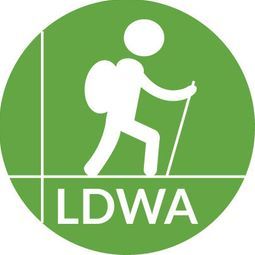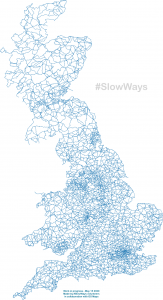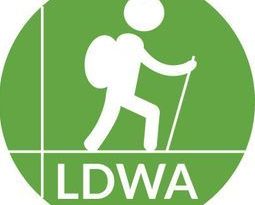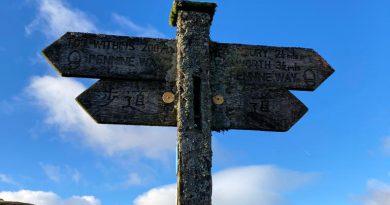LDWA – The Slow Ways Project led by Dan Raven-Ellison
One exciting new walking project is Slow Ways, an attempt led by Dan Raven-Ellison to create a network of walking routes across the UK. This is of interest to the LDWA, we’re always keen to find ways of connecting shorter routes together to create something longer, but what’s impressive is how many people have already engaged in this project. They’re looking for 10,000 volunteers to help with this work and I’m hopeful many members of the LDWA will be interested in this.
There’s lots more information on the Slow Ways official web-site, but David Morgan, the national LDWA chair, and myself, the national LDWA communications officer, were keen to find out even more. Below are some questions and answers from Dan, which we will also be using in numerous ways on our social media and internal communications.
Q. Can people use this project to plan long-distance walks?
That’s one of the aspects of the Slow Ways that I’m most excited about. While each Slow Way route connects two neighbouring settlements, people will be able to combine routes for long distance journeys. Someone who wants to walk from Falmouth to Huddersfield or Swansea to Norwich will be able to see multiple options for making those journeys that use existing footpaths. Critically, they’ll also be able to see a village, town or city that they can stop, rest or sleep in at the end of each day.
We are so fortunate to have a wealth of incredible long-distance paths and routes in Great Britain, but while they do connect on the ground they don’t necessarily connect in people’s imaginations, ambitions or stories. The Slow Ways will help more people make more of those connections more of the time.
Q. You’ve got a large number of people working with you on the project already, how did you engage so many people so quickly?
For many different reasons. Most people involved just got the idea of the Slow Ways straight away on an intuitive level. In February we held a hack-day to start creating the network that was attended by 70 people from across the country. People for a mixture of reasons. They either liked maps and plotting routes, loved walking, were interested in the environmental, health, economic, cultural and social benefits of more people walking or wanted to be part of the Slow Ways in a very personal way.
After the success of the hackday I had planned to organise 10 more events in 10 different regions of Great Britain, but then Covid-19 hit and the country went into lockdown. In response to that challenge a small team of volunteers from the hackday spent four weeks creating an overview plan for the network and setting things up so that anyone who loved maps, were missing walking and had an internet connection. We then used Twitter, Zoom, Skype, Google Docs and OS Maps to recruit and train 700 volunteers who then created over 7,000 Slow Ways routes that stretch for over 100,000km.
Lockdown certainly helped to bring people together and catalyse the effort.
Q. How could LDWA members help you on this project?
We’d loved LDWA members to help with the project. We are going to be looking for 10,000 volunteers to help test the routes. We need people to ground truth, verify and rate all the routes and in some places, suggest new ones. I’m hoping that we’ll have everything set up for people to help with this giant effort before the autumn.
Anyone who wants to help should sign-up for the Slow Ways newsletter on my website ravenellison.com. We’re currently working on a website to host the development of the routes.
Q. Do you think that the lockdown has brought about a new era in walking and people wanting to explore their local communities?
I think there is lots of evidence that more people have been out exploring their local neighbourhoods. I’m interested to see how this translates into people deciding to walk longer distances. I think the Slow Ways can help with that as people want to avoid public transport and walking to a neighbouring settlement will be an option for many people.
Q. Is ‘Slow Ways’ relying on paths that are known to exist on the ground, or theoretical rights of way that in reality have been lost?
Slow Way is a principle and an idea. It’s the idea that you can walk to your neighbouring settlement and the principle that it should be possible to do so directly, safely and enjoyably. This is not always the case.
Each Slow Way might have multiple route options. These route options may be more or less direct, safe, doable or accessible. Volunteers were asked to create Slow Ways routes that used footpaths and rights of way that are visible on OS Maps. There will certainly be many “lost ways” included in the network and we need to do the ground truthing to find, test and potentially even challenge some of these.
I’m also interested in where there are no safe rights of way but should be. The Slow Ways help to expose places where the walk between neighbouring settlements is unacceptable. In these places I hope they inspire parish councils, councils and local groups to create new routes and rights of way.
Q. Will ‘Slow Ways’ liaise with the Ramblers ‘Don’t Lose Your Way’ campaign as ancient routes are protected for the future?
I’m good friends with Jack Cornish who leads on that and Jack’s been volunteering on the Slow Ways from the start. We’re chatting about the best ways to collaborate and combine energies.
Q. And for many of our members this would be of interest, would these walks let them encompass a pub visit easily?
Great question. When designing the routes I asked volunteers to make sure they, as far as possible 1) Start and finish at a good central point 2) are direct 3) are off-road 4) are safe and accessible 5) have resting places every 5-10km 6) pass through train and bus stations 7) are enjoyable and beautiful and 8) use already established routes.
The “resting points” requirement meant using OS Maps to find regular villages where people could stop for rest, sustenance and potentially a bed. The guidance was to look for a pint glass symbol on Explorer maps as an indicator for good places to pick. So yes, in some ways the Slow Ways could be considered to be world’s longest-distance pub crawl.




